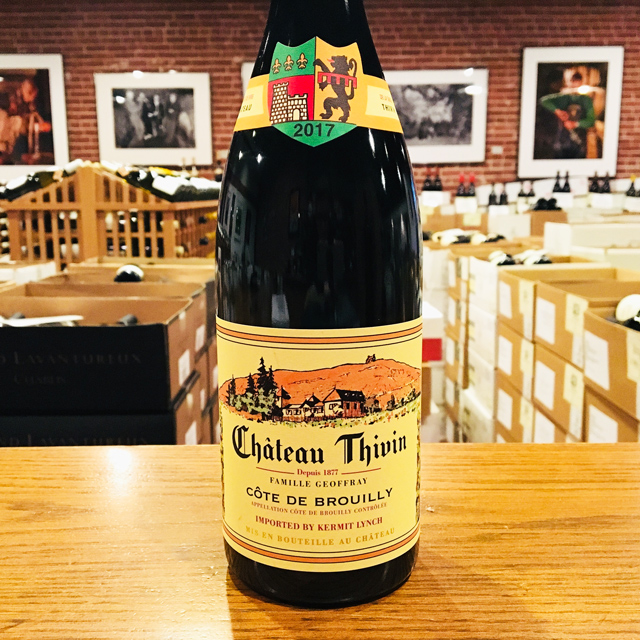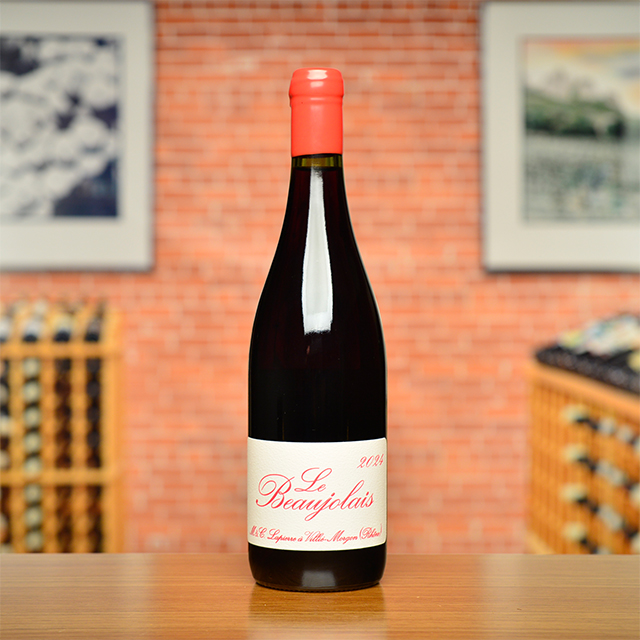Notify me
2017 Côte de Brouilly
Château Thivin
Château Thivin is the perfect starting point for a tour of Beaujolais. This historic fourteenth-century château was purchased by Zaccharie Geoffray in 1877, and since then, the estate and its winemaking practices have been passed down through the six generations of his descendants. Drawing on vinification practices of the nineteenth century, the entire production is gravity fed, and the reds are all raised in large, old wooden foudres. The blue volcanic terroir of Côte de Brouilly marks this great cru with a powerful minerality, supported by a deep garnet color and aromas of cherries, violets, and clove. For more than one hundred vintages, Château Thivin has set the benchmark for Côte de Brouilly.
—Will Meinberg
| Wine Type: | red |
| Vintage: | 2017 |
| Bottle Size: | 750mL |
| Blend: | Gamay Noir |
| Appellation: | Côte de Brouilly |
| Country: | France |
| Region: | Beaujolais |
| Producer: | Château Thivin |
| Winemaker: | Claude Geoffray |
| Vineyard: | Average of 50 years, 8.3 ha |
| Soil: | Blue volcanic rock comprised of plagioclase and biotite |
| Aging: | Ages in oak foudres for six months before bottling |
| Farming: | Organic (certified) |
| Alcohol: | 13.5% |
More from this Producer or Region

2024 Beaujolais Villages Rosé
France | Beaujolais
Sourced from the pink granite terroir of Brouilly, this rosé is simply delicious, with good grip and notes of summery red berries.

2023 Côte-de-Brouilly
France | Beaujolais
Loads of fun—juicy, round, structured, yet always elegant and focused. A classic favorite.

2018 Brouilly
France | Beaujolais
A generous dash of plump, sun-ripened fruit enveloping a granite core

2024 Beaujolais “Le Beaujolais”
France | Beaujolais
“Le Beaujolais” is silky, perfumed, and incredibly fresh, exhibiting the pleasure factor we expect from every bottle to come out of the Lapierre cellars.

2023 Côte de Brouilly
France | Beaujolais
Brambly and mineral, this bottling exudes both the convivial charm of Gamay and the crunchy intensity of the Côte de Brouilly.

2023 Morgon “Cuvée Corcelette”
France | Beaujolais
Sweet, earthy fruit and sensuous, velvety texture.

2023 Brouilly “Reverdon”
France | Beaujolais
This bottling is classic Brouilly, balanced and old-school, and showcases the beauty of Gamay.

2023 Vin de France Blanc “Perle de Gamay”
France | Beaujolais
Notes of stones, pear, and citrus... Enjoy as a refreshing, mineral apéritif or alongside your favorite fresh seafood.

2023 Beaujolais Blanc “Clos de Rochebonne”
France | Beaujolais
Rochebonne offers Chardonnay fruit that’s both racy and sun-kissed

2023 Chénas “Les Blémonts”
France | Beaujolais
Structured yet full of energy, with notes of blueberry, spice, and other things nice.
About The Producer
Château Thivin
It is no surprise that Château Thivin is the benchmark domaine of the Côte de Brouilly; everything about it is exceptional. Built in the fifteenth century on an ancient volcano which juts out steeply into the valley below, Thivin is the oldest estate on Mont Brouilly, In 1976, Richard Olney took Kermit to visit on their first wine trip together. It was Olney’s top recommendation in the whole of the Beaujolais region. The current generation of the Geoffray family continues their tradition. Today their grandnephew Claude, his wife Evelyne, and their son Claude-Edouard continue the tradition as staunch and proud defenders of the terroir of the Côte de Brouilly.
About The Region
Beaujolais

After years of the region’s reputation being co-opted by mass-produced Beaujolais Nouveau and the prevalence of industrial farming, the fortunes of vignerons from the Beaujolais have been on the rise in the past couple of decades. Much of this change is due to Jules Chauvet, a prominent Beaujolais producer who Kermit worked with in the 1980s and arguably the father of the natural wine movement, who advocated not using herbicides or pesticides in vineyards, not chaptalizing, fermenting with ambient yeasts, and vinifying without SO2. Chief among Chauvet’s followers was Marcel Lapierre and his three friends, Jean Foillard, Guy Breton, and Jean-Paul Thévenet—a group of Morgon producers who Kermit dubbed “the Gang of Four.” The espousal of Chauvet’s methods led to a dramatic change in quality of wines from Beaujolais and with that an increased interest and appreciation for the AOC crus, Villages, and regular Beaujolais bottlings.
The crus of Beaujolais are interpreted through the Gamay grape and each illuminate the variety of great terroirs available in the region. Distinguishing itself from the clay and limestone of Burgundy, Beaujolais soils are predominantly decomposed granite, with pockets of blue volcanic rock. The primary vinification method is carbonic maceration, where grapes are not crushed, but instead whole clusters are placed in a tank, thus allowing fermentation to take place inside each grape berry.
Much like the easy-going and friendly nature of many Beaujolais vignerons, the wines too have a lively and easy-drinking spirit. They are versatile at table but make particularly good matches with the local pork sausages and charcuterie. Though often considered a wine that must be drunk young, many of the top crus offer great aging potential.
More from Beaujolais or France
2024 Vin de France Rouge “Raisins Gaulois”
M. & C. Lapierre France | Beaujolais
2018 Brouilly
Alex Foillard France | Beaujolais
2021 Beaujolais Blanc “Terrain Rouge”
Jean-Paul et Charly Thévenet France | Beaujolais
2023 Côte de Brouilly
Château Thivin France | Beaujolais
2023 Morgon “Cuvée Corcelette”
Jean Foillard France | Beaujolais
2024 Beaujolais Blanc
Domaine Dupeuble France | Beaujolais
2022 Régnié “Grain & Granit”
Jean Paul et Charly Thévenet France | Beaujolais
2023 Chénas “Chassignol”
Domaine Thillardon France | Beaujolais
2023 Brouilly “Reverdon”
Château Thivin France | Beaujolais
2023 Moulin-à-Vent “Sous la Roche”
Domaine Thillardon France | Beaujolais
2023 Morgon “Vieilles Vignes”
Guy Breton France | Beaujolais
2022 Chiroubles “Cuvée Léa”
Guy Breton France | Beaujolais
2024 Vin de France Rouge “Raisins Gaulois”
M. & C. Lapierre France | Beaujolais
2018 Brouilly
Alex Foillard France | Beaujolais
2021 Beaujolais Blanc “Terrain Rouge”
Jean-Paul et Charly Thévenet France | Beaujolais
2023 Côte de Brouilly
Château Thivin France | Beaujolais
2023 Morgon “Cuvée Corcelette”
Jean Foillard France | Beaujolais
2024 Beaujolais Blanc
Domaine Dupeuble France | Beaujolais
2022 Régnié “Grain & Granit”
Jean Paul et Charly Thévenet France | Beaujolais
2023 Chénas “Chassignol”
Domaine Thillardon France | Beaujolais
2023 Brouilly “Reverdon”
Château Thivin France | Beaujolais
2023 Moulin-à-Vent “Sous la Roche”
Domaine Thillardon France | Beaujolais
2023 Morgon “Vieilles Vignes”
Guy Breton France | Beaujolais
2022 Chiroubles “Cuvée Léa”
Guy Breton France | Beaujolais
Kermit once said...

Kermit once said...
For the wines that I buy I insist that the winemaker leave them whole, intact. I go into the cellars now and select specific barrels or cuvées, and I request that they be bottled without stripping them with filters or other devices. This means that many of our wines will arrive with a smudge of sediment and will throw a more important deposit as time goes by, It also means the wine will taste better.



















